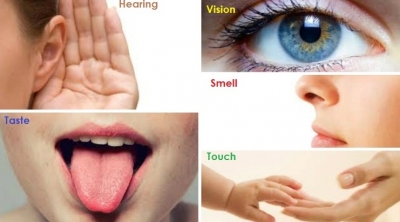
SENSES
Our senses make us aware of the world around us, and the changes that are happening in it. The eyes detect light waves, and the ears sound waves, enabling us to see and hear. The tongue and nose detect dissolved chemicals so we can taste, smell, and enjoy flavours. The skin allows us to feel the texture and warmth of objects.
- VISION: Vision is the most important sense, providing the brain with an immense amount of information about the body’s surroundings. Light reflected from, or produced by, outside objects is automatically focused onto a layer of light receptors that lines the back of the eye. In response, these receptors send signals to areas at the back of the brain. From there, we can determine what we are looking at and where it is, thus enabling us to “see” moving, 3-D images in colour.
- HEARING: The ears detect waves of pressure, called sound waves that travel through the air. Sound waves are produced by objects, such as a ringing mobile phone or bell, which move or vibrate. The waves pass into the inner ear, which is enclosed in bone on the side of the skull. Here, receptors convert pressure waves into signals. The signals travel to the brain, which identifies the pitch, volume, and direction of the sound.
- TASTE: Small projections on the tongue, called papillae, house taste receptors called taste buds. Food molecules dissolved in saliva are detected by the taste buds. These can distinguish between five basic tastes — sour, sweet, salty, bitter, and umami (savoury and meaty). As well as helping us to enjoy food, our sense of taste enables us to detect foods that may be poisonous.
- TOUCH: The skin acts like a sense organ. It contains several different types of receptors that enable us to “feel” our surroundings. Most are touch receptors that send signals to the brain when the skin comes into contact with objects. Some detect light touch, some heavier pressure, and some vibrations. Other receptors in the skin pick up temperature changes or detect pain.
- SMELL: The nose can detect more than 10,000 different smells. When air is breathed into the nose, odour molecules dissolve in watery mucus and are detected by odour receptors high in the roof of the nasal cavity. Together, the senses of smell and taste enable us to detect flavours. Smell is more important, however, which explains why food lacks flavour when we have a blocked nose. Some smells, such as those produced by burning, can warn us of danger.
Picture Credit : Google




